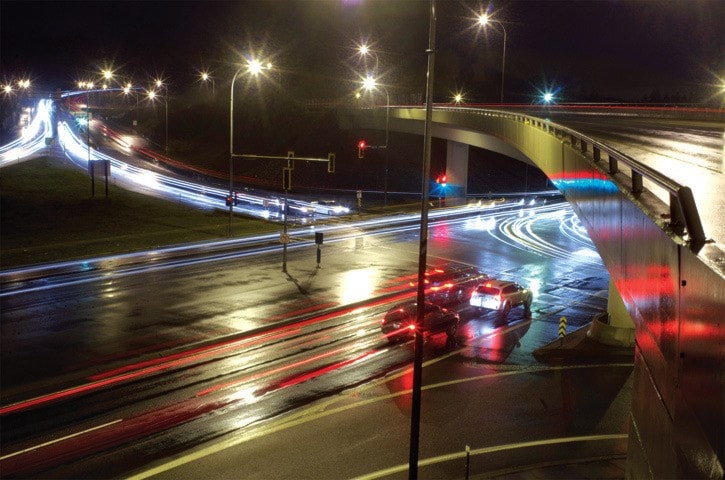Three years ago Nanaimo became the first city in Canada to apply a special type of road paint that allowed motorists to see pavement markings in dark, rainy conditions.
The special type of road paint, known as Continuous Wet Night, was applied over nine kilometres in both directions on Island Highway between Brenton Page Road and Kipp Road with only the centre lines receiving the new product.
Ministry of Transportation regional project manager Darren Englund said Continuous Wet Night cost taxpayers roughly $120,000 and was extremely effective at first.
“It was very vivid, especially at night,” Englund said.
There are various types of road markings available for jurisdictions to use. The most common type of application is standard road paint with glass beads. When a motorist’s headlights hit standard road paint markings the beads reflect the light back to the motorist, making the lines visible at night. However, when the beads are covered in water, the light becomes distorted, thus creating poor visibility for the driver.
What separates Continuous Wet Night from traditional road paint is the type of beads used. Continuous Wet Night uses microcrystalline ceramic beads that use the water to help reflect the light back to the driver in wet night conditions, whereas traditional road paint uses large glass beads.
However, since the application was applied nearly four years ago, motorists are unlikely to notice any visible difference between Brenton Page Road and Kipp Road in dark rainy conditions. The ministry was well aware that the application’s main feature wouldn’t last long, Englund said.
“Over the years it wears down and we knew that was going to happen,” he said.
“It is still above our thresholds, meaning we don’t need to repair it or repaint it, but it does start getting lower and lower to about the equivalent of what regular paint is. So for the average driver they probably don’t see a negligible difference in the visual aspect of it.”
Englund noted that over a five-year period it would be cheaper to repaint the road with traditional paint, but added that there was an added benefit to the $120,000 cost of Continuous Wet Night.
“We have a more consistent line throughout the year in terms of safety and reflectivity ... There has got to be a safety factor into it because in the end [Continuous Wet Night] is costing us,” Englund said.
Since Continuous Wet Night was applied, the ministry has not had to repaint the section of road and won’t need to replace it for at least two more years, which was one of the reasons behind applying it.
“That’s the benefit that we are looking at. The fact that we are spending a higher premium on Day 1 but we don’t have to paint it again … we leave it and let it go its life.”
The ministry has mulled over the idea of applying Continuous Wet Night pavement markings to other areas on the Island, such as along the Malahat, but are still testing a variety of other products.
“A test project was done, and I believe it was on Highway 3 in the Lower Mainland, where it had about 10 kilometres of paint lines redone and every kilometre was a different product,” Englund said. “Even in the last three to four years we haven’t confirmed anything yet.”
